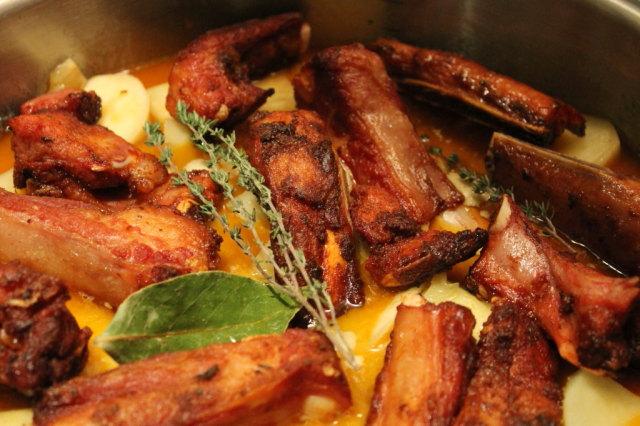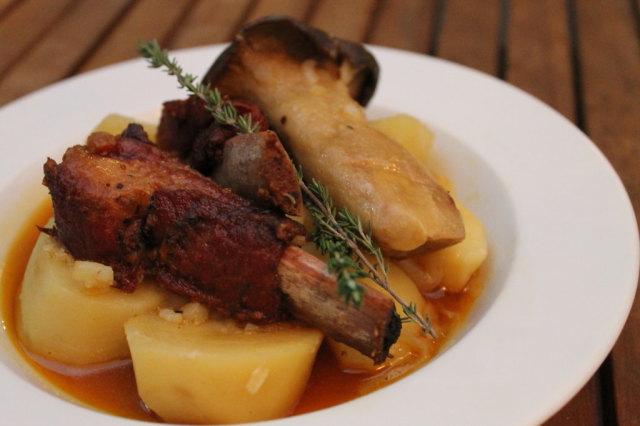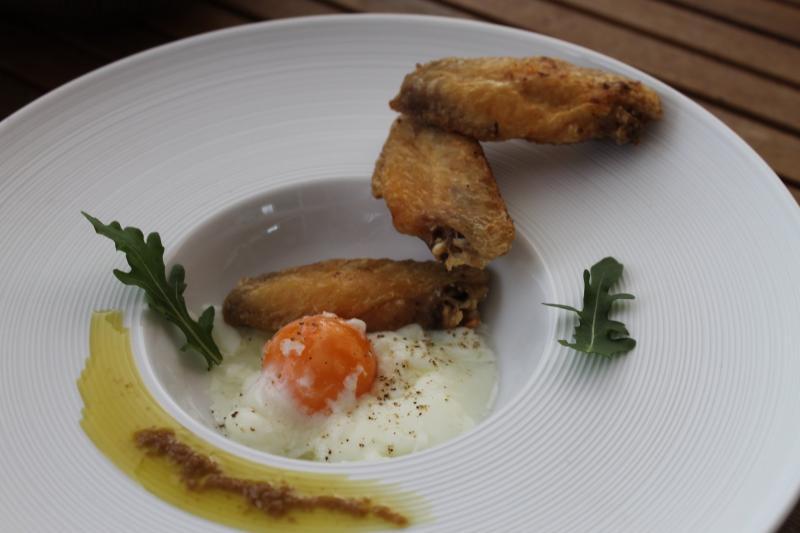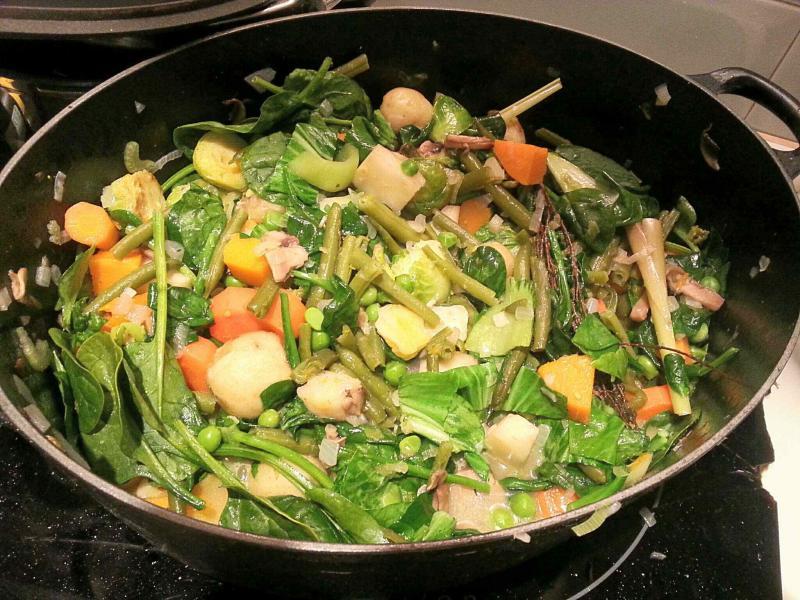
EnriqueB
participating member-
Posts
399 -
Joined
-
Last visited
Content Type
Profiles
Forums
Store
Help Articles
Everything posted by EnriqueB
-
Hi, adding water is not something usually found on pavlova recipes, so I wonder what its function and effects are. Given that cooking the Pavlova is really a matter of drying rather than "baking" it, the extra water seems to defeat this purpose, at first sight?
-
Feeding paella to such a big crowd is problematic because the essence of the dish (irrespective of local issues of whether it should have rabbit or seafood) is to have a really thin layer of rice, to get it adequately dry and get the "socarrat" crust. Meaning that for 100 you would need a really huge pan (or, many pans). You'll likely have to compromise and cook a considerably wider layer or rice, which turns it more into an "arroz de" rather than a paella.
-
In fact about 2 hours should be enough. Realize, though, that pasteurization reduces vegetative forms of pathogens to safe levels, but not some spores or toxins. Fast chilling, low enough fridge temperature, limiting conservation time (one week at <5ºC should be Ok) and (optionally) searing all surface before consuming take care of that part.
-
You have completely pasteurized the wings with that time/temperature profile, then chilled them fast. Plus you will sear them before eating, which will practically sterilize the surface (be sure to cover all the surface). They should be really safe for at least one week in a <5ºC fridge.
-
La.va. bags are 90 µm, they were kind to send me the technical sheet when I asked for it. Don't know how this measure converts to mil, though. The bags are excellent.
-
Whites set at a higher temp than yolks. Runny whites are standard in these low temp eggs. Many of us don't like them like that, so we fully cold the egg in cold water, then dunk in boiling water for 2/3 minutes, which doesn't affect the yolk much but sets the whites. There is also a fast method intended to obtain similar results using 72-75C water and about 15 minutes. There's a whole thread devoted to sous-vide eggs, have a look at that discussion.You didn't mention the size of your eggs. Yolks of XL eggs should not get hard in 50 min in 63C water, but M-sized eggs in a slightly miscalibrated bath may do (time and egg size do matter, even though it was said for a while they didn't).
-
I usually follow the excellent Sandra Avital's recipes (in french, I'm afraid) at http://sandrakavital.blogspot.co.uk/2010/07/pavlova-royale-rhubarbe-cerises-creme.html or http://sandrakavital.blogspot.co.uk/2006/12/pavlovas-en-tutus-pour-dorian.html
-
That's a good technique, but take into account that killing bacteria requires the surface to achieve a given temperature for a given time. Dunking for 10 seconds is usually recommended when starting from fridge temperature, I hesitate that pasteurization is achieved using the same short time when you start from frozen... About the other part, enough to say that my blog is titled "Dorar no sella los jugos", which means "searing does not seal in juices" in Spanish...
-
Given the profile (50ºC for 30 minutes), they are not pasteurized and should be considered equivalent to raw. If I understand correctly, most safety guidelines would claim this to be apt only for inmediate consumption?
-
Have you tried to find the Iwatani torch in chinese supplies stores? Don't know where in Europe you live but in Madrid/Spain they are available in some of these shops at a very good price.
-
The longer the better. Thanks you! Even if I use a 3.35" needle for a 1" piece of meet, will the needle still stay attached to the bag? Even though only 25-30% of the needle is inside the meat? I have both probes. Both will do the job, but I find myself using the shorter one more often, as I normally don't sous-vide very thick pieces, and for thinner pieces the large one may have a too big portion outside of the bag. On the other hand, if you have the short one and you happen to want to measure a really thick piece you can do nothing... I suppose a lot of my pieces are about 1-1.5 inches thick. Is it very difficult to keep the probe in place in those cases? I suppose the foam tape will add a bit of thickness (polyscience sous vide foam tape), plus you could also insert the probe at an angle. You will not have problems with the long one, just put it at an angle or even all through the long section (entering from the piece side) if needed. I first only had the long one and it stayed in place, just be careful when introducing and removing the bag.
-
The longer the better. Thanks you! Even if I use a 3.35" needle for a 1" piece of meet, will the needle still stay attached to the bag? Even though only 25-30% of the needle is inside the meat? I have both probes. Both will do the job, but I find myself using the shorter one more often, as I normally don't sous-vide very thick pieces, and for thinner pieces the large one may have a too big portion outside of the bag. On the other hand, if you have the short one and you happen to want to measure a really thick piece you can do nothing...
-
I place myself on the opposite camp. I've never enjoyed the kind-of-chewy texture of traditionally braised tough meats (though I love the sauce they produce), whereas I love it sous-vide long time at a low temperature. As for veal cheeks, my preference goes for 72 hours at 60ºC, you can see a picture of the result here: http://dorarnosella.files.wordpress.com/2012/07/razones-cocinar-al-vacio-carrilleras-ternera-con-patatas-hb.jpg Sometimes 48 hours can be enough, bag pieces separate and remove one after 48 hours, then try all and you'll know your preferred time for next time.
-
Hi basquecook, wonderful looking roast! I assume you live in Spain? In that case, may I ask what type of pork cut did you order? I've tried porchetta a couple of times but butchers here in Madrid are not used to that cut with the skin on and always had problems....
-
I have just found a Julabo page annoucing two new water baths "Sous Vide Pure" and "Sous Vide Prime" intended for home use: http://fusionchefsousvide.com/ Pure is 9 liters, at 299$, and Prime is 11 liters, at 399$. They look like direct competence of the Sous Vide Supreme units, to say the least: the site also sells a vacuum sealer and sous-vide recipe books much like SV Supreme.... They seem US-only. I don't remember reading any info about these units here. Someone has any information?
-
Long without posting. Here I go. Pressure-cooked potatoes with oyster mushrooms and marinated pork ribs: Sous-vide egg, chicken wings, and garlic confit oil. Inspired by a Mugaritz dish: Vegetable stew, each vegetable first pressure-steamed, then all briefly finished together with ibérico ham stock: Chicken wings, sous-vide 12 hours at 60ºC & deep-fried:
-
I like to cut the head leaving a bit of meat so I can sear it and enjoy the roe. Then peel the tail and cook sous-vide with a bit of butter at 51C for about 15-20 minutes. One of the biggest discoveries of sous-vide, such a sweet, delicate flavor. One degree more and taste and texture start to change, IMO. At about 55C seafood such as prawns release enzymes that change the flavor and texture.
-
This tecnique appeared in Modernist Cuisine, but I never made it work very successfully, plus it is slow (about two minutes per egg) so it does not escalate well to many eggs. Should anyone have some hint on how to make it work, please share!
-
Another vote for the OXO, cannot live without it. Prefer it to any Y shaped I've tried.
-
New Spanish charcuterie/butchery book Fall 2013
EnriqueB replied to a topic in Cookbooks & References
That sounds great! I would ask that the book can be used both by Spaniards and Americans. Meaning that if you have to propose ingredients changes to adapt to what is available in the US or something (which would be understandable in an English book) you also leave the original ingredients or terms so we can use it also in Spain :-) Sadly there is not a real reference book about the topic in Spanish... As a general thought, it seems to me that here in Spain we have to wait for foreigners to come and write practical useful cooking books about what we do here. Same as happened with Modernist Cuisine. Though much of that movement originated in Spain, all books published here were huge expensive coffee-table style books focusing mainly on beautiful pictures, restaurant history and "philosophical" concepts instead of practical information to be applied in your cooking. Seems english-speaking people are more practical, e.g. Blumenthal books or Modernist Cuisine...- 10 replies
-
- Charcuterie
- Cookbook
-
(and 2 more)
Tagged with:
-
Inmediate consumption or fast cooling plus limiting refrigeration time to 3 to 5 days (depending on your fridge temperature) or freeze should be enough for protecting against botulism, I cook oxtail regularly for 100 hours without any acid in the bags.
-
Thanks for your answer Pedro. I know this is an extremelly unlikely event, and when I needed it (e.g. when my wife was pregnant) I did pasteurize the eggs in-shell in the water bath (Modernist Cuisine also proposes 2 hours at 55ºC), though I don't do it normally. The question was because I like to state food safety details of every new sous-vide recipe I propose on my blog, and I just wanted to double-check my understanding of the 75ºC-egg case before publishing a post.
-
I go low tech here: I have a thin string on which I've done 14, 15, 16 and 17 cm marks. Measuring circunference with it is fast, measures between the marks are approximated but that has turned good enough for me. One question: the 75ºC fast method does not pasteurize to core, does it? Should an egg be infected inside with salmonella, I understand the core is not kept long enough to a high enough temperature to have a 6.5 log reduction?
-
The GMH 3710 / SET1 ( -20, 0, 70 °C ) Calibration Pt100-High-Precision Measuring System is EUR 254.- excl.VAT. To see the price info you have to create an account (free) and log in. See if you have a calibration laboratory (e.g. http://www.testo.es/online/abaxx-?$part=PORTAL.ESP.HomeDesk&$event=go-home ) nearby for recalibration. Thanks Pedro!
-
Don't think so...






